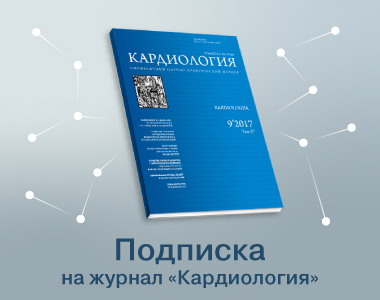Systemic inflammatory response in cardiac surgery: possibilities of using colchicine
https://doi.org/10.18087/cardio.2023.7.n2229
Abstract
Aim. To evaluate manifestations of systemic inflammatory response (SIR) and the effect of the colchicine therapy on SIR severity in patients with ischemic heart disease (IHD) after coronary artery bypass grafting (CABG) with extracorporeal circulation (EC).
Material and methods. This study included 100 patients aged 62+6.3 years with stable IHD and multivessel coronary atherosclerosis scheduled for CABG with EC. Patients of group 1 (n=50) were administered with a single dose of colchicine (Colchicum-Dispert) 500 µg 4 hours before surgery followed by 500 µg twice a day for 10 days after surgery. Patients of group 2 (n=50) received a standard treatment, including nonsteroid anti-inflammatory drugs after surgery. Severity of the inflammatory response was evaluated by measuring blood cytokines.
Results. In the postoperative period, patient of group 1 showed a tendency toward a lower incidence of pleurisy and heart rhythm disorders in the form of paroxysmal atrial fibrillation (AF) (p=0.18). Levels of the anti-inflammatory cytokines, interleukin-10 (IL-10) and interleukin-6 (IL-6), were significantly increased in both groups at 6 hours after surgery (p<0.05); at the same time, in group 1, IL-10 remained increased also at 10 days after surgery (р=0.0002). No significant time-related changes in the proinflammatory cytokines, tumor necrosis factor α (TNF-α) and interleukin 1β (IL-1β), were observed. At 3 days post-CABG, there were significant increases in tissue inhibitors of matrix metalloprotease 1 (TIMP-1) (р<0.0001) and matrix metalloproteinase 9 (MMP-9) (р<0.001); at the same time, patients of group 1 had lower MMP-9 concentrations than patients of group 2 (p<0.05). At 10 days of postoperative period, these values were comparable with the background values. Increases in neopterin compared to preoperative values were found in both groups on days 3 and 10 after surgery (р <0.0001).
Conclusion. CABG with EC is associated with the activation of SIR. The colchicine therapy at a dose of 500 µg 4 hours prior to surgery and 500 µg twice a day for 10 days after surgery reduces manifestations of SIR, which is clinically evident as a tendency to reduced incidence of pleurisy and arrhythmias, and does not result in the development of serious complications. The dynamics of matrix metalloproteinases indicates that the colchicine treatment is promising for decreasing the risk of CHF progression and myocardial remodeling in patients with IHD.
About the Authors
M. L. DiakovaRussian Federation
Cand. Sci. (Med.), Research Scientist,
Tomsk
V. M. Shipulin
Russian Federation
Dr. Sci. (Med.), Chief of Researcher Cardiology Research Institute,
Tomsk
Y. S. Svirko
Russian Federation
MD, PhD, Dr. Sci. (Med.) Doctor of Clinical Laboratory Diagnostics Department of Intensive Care Cardiology Research Institute,
Tomsk
A. M. Gusakova
Russian Federation
Cand. Sciences (Pharm.), Researcher, Department of Clinical Laboratory Diagnostics Cardiology Research Institute,
Tomsk
Y. K. Podoksenov
Russian Federation
Dr. Sci. (Med.), Leading Research Scientist, Department of Cardiovascular Surgery,
Tomsk
N. O. Kamenshchikov
Russian Federation
Cand. Sci. (Med.), Intensive Care Physician,
Tomsk
B. N. Kozlov
Russian Federation
Dr. Sci. (Med.), Head of Department of Cardiovascular Surgery,
Tomsk
References
1. Krichevsky L.A., Rybakov V.Yu., Dvoryadkin A.A., Protsenko D.N. Systemic inflammatory response in cardiac surgery. Russian Journal of Anaesthesiology and Reanimatology. 2021;3:94–102. DOI: 10.17116/anaesthesiology202103194
2. Lomivorotov V.V., Efremov S.M., Pokushаlov E.А., Boboshko V.А. Atrial fibrillation after cardiac surgery: pathophysiology and methods of prevention. Bulletin of Anesthesiology and Resuscitation. 2017;14(1):58–66. DOI: 10.21292/2078-5658-2017-14-1-58-66
3. Ministry of Health of the Russian Federation. Clinical recommendations. Postcardiotomy syndrome. I97.0. 2020. Av. at: https://racvs.ru/clinic/files/2020/postcardiotomy_syndrome.pdf.
4. Nidorf SM, Fiolet ATL, Mosterd A, Eikelboom JW, Schut A, Opstal TSJ et al. Colchicine in Patients with Chronic Coronary Disease. New England Journal of Medicine. 2020;383(19):1838–47. DOI: 10.1056/NEJMoa2021372
5. Permanyer-Miralda G, Sagristá-Sauleda J, Soler-Soler J. Primary acute pericardial disease: A prospective series of 231 consecutive patients. The American Journal of Cardiology. 1985;56(10):623–30. DOI: 10.1016/0002-9149(85)91023-9
6. Imazio M, Brucato A, Ferrazzi P, Rovere ME, Gandino A, Cemin R et al. Colchicine Reduces Postoperative Atrial Fibrillation: Results of the Colchicine for the Prevention of the Postpericardiotomy Syndrome (COPPS) Atrial Fibrillation Substudy. Circulation. 2011;124(21):2290–5. DOI: 10.1161/CIRCULATIONAHA.111.026153
7. Seferović PM, Ristić AD, Maksimović R, Simeunović DS, Milinković I, Seferović Mitrović JP et al. Pericardial syndromes: an update after the ESC guidelines 2004. Heart Failure Reviews. 2013;18(3):255–66. DOI: 10.1007/s10741-012-9335-x
8. Buziashvili Yu.I., Koksheneva I.V., Samsonova N.N., Abukov S.T., Buziashvili V.Yu., Klimovich L.G. The dynamics of inflammatory factors in the early postoperative period after various techniques of coronary artery bypass grafting. Cardiology and Cardiovascular Surgery. 2015;8(1):4–11. DOI: 10.17116/kardio2015814-11
9. Shimoda M. Extracellular vesicle-associated MMPs: A modulator of the tissue microenvironment. V. 88. P. 35-66. [DOI: 10.1016/ bs.acc.2018.10.006]. In: Advances in Clinical Chemistry. [ISBN: 978- 0-12-817143-1] Elsevier;2019.
10. Yabluchanskiy A, Ma Y, Iyer RP, Hall ME, Lindsey ML. Matrix Metalloproteinase-9: Many Shades of Function in Cardiovascular Disease. Physiology. 2013;28(6):391–403. DOI: 10.1152/physiol.00029.2013
11. Belenkov Yu.N., Privalova E.V., Iusupova A.O., Zhito A.V. Markers of Vascular Wall Fibrosis Metalloproteinase-9 and Tissue Inhibitor of Metalloproteinases-1 in Patients with Ischemic Heart Disease with and without Concomitant Type-2 Diabetes Mellitus. Kardiologiia. 2019;59(5):61–6. DOI: 10.18087/cardio.2019.5.10258
12. Shirai R, Sato K, Yamashita T, Yamaguchi M, Okano T, Watanabe‐Kominato K et al. Neopterin Counters Vascular Inflammation and Atherosclerosis. Journal of the American Heart Association. 2018;7(3):e007359. DOI: 10.1161/JAHA.117.007359
13. Tardif J-C, Kouz S, Waters DD, Bertrand OF, Diaz R, Maggioni AP et al. Efficacy and Safety of Low-Dose Colchicine after Myocardial Infarction. New England Journal of Medicine. 2019;381(26):2497–505. DOI: 10.1056/NEJMoa1912388
Review
For citations:
Diakova M.L., Shipulin V.M., Svirko Y.S., Gusakova A.M., Podoksenov Y.K., Kamenshchikov N.O., Kozlov B.N. Systemic inflammatory response in cardiac surgery: possibilities of using colchicine. Kardiologiia. 2023;63(7):39-46. https://doi.org/10.18087/cardio.2023.7.n2229
















